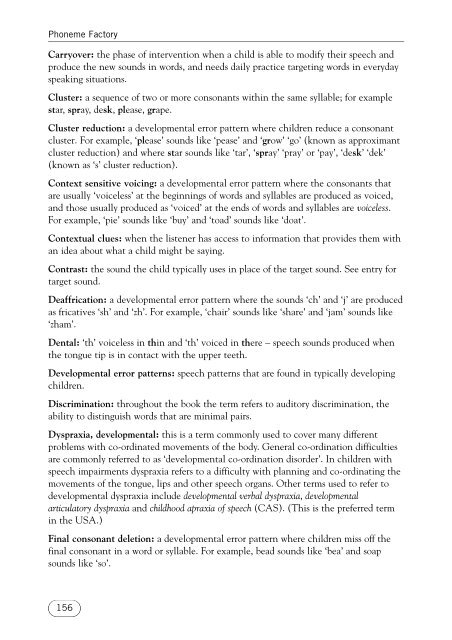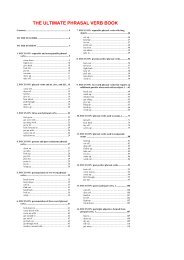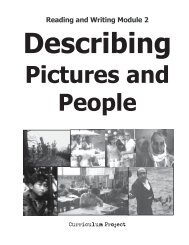Developing Speech and Language Skills - Noel's ESL eBook Library
Developing Speech and Language Skills - Noel's ESL eBook Library
Developing Speech and Language Skills - Noel's ESL eBook Library
Create successful ePaper yourself
Turn your PDF publications into a flip-book with our unique Google optimized e-Paper software.
Phoneme FactoryCarryover: the phase of intervention when a child is able to modify their speech <strong>and</strong>produce the new sounds in words, <strong>and</strong> needs daily practice targeting words in everydayspeaking situations.Cluster: a sequence of two or more consonants within the same syllable; for examplestar, spray, desk, please, grape.Cluster reduction: a developmental error pattern where children reduce a consonantcluster. For example, ‘please’ sounds like ‘pease’ <strong>and</strong> ‘grow’ ‘go’ (known as approximantcluster reduction) <strong>and</strong> where star sounds like ‘tar’, ‘spray’ ‘pray’ or ‘pay’, ‘desk’ ‘dek’(known as ‘s’ cluster reduction).Context sensitive voicing: a developmental error pattern where the consonants thatare usually ‘voiceless’ at the beginnings of words <strong>and</strong> syllables are produced as voiced,<strong>and</strong> those usually produced as ‘voiced’ at the ends of words <strong>and</strong> syllables are voiceless.For example, ‘pie’ sounds like ‘buy’ <strong>and</strong> ‘toad’ sounds like ‘doat’.Contextual clues: when the listener has access to information that provides them withan idea about what a child might be saying.Contrast: the sound the child typically uses in place of the target sound. See entry fortarget sound.Deaffrication: a developmental error pattern where the sounds ‘ch’ <strong>and</strong> ‘j’ are producedas fricatives ‘sh’ <strong>and</strong> ‘zh’. For example, ‘chair’ sounds like ‘share’ <strong>and</strong> ‘jam’ sounds like‘zham’.Dental: ‘th’ voiceless in thin <strong>and</strong> ‘th’ voiced in there – speech sounds produced whenthe tongue tip is in contact with the upper teeth.Developmental error patterns: speech patterns that are found in typically developingchildren.Discrimination: throughout the book the term refers to auditory discrimination, theability to distinguish words that are minimal pairs.Dyspraxia, developmental: this is a term commonly used to cover many differentproblems with co-ordinated movements of the body. General co-ordination difficultiesare commonly referred to as ‘developmental co-ordination disorder’. In children withspeech impairments dyspraxia refers to a difficulty with planning <strong>and</strong> co-ordinating themovements of the tongue, lips <strong>and</strong> other speech organs. Other terms used to refer todevelopmental dyspraxia include developmental verbal dyspraxia, developmentalarticulatory dyspraxia <strong>and</strong> childhood apraxia of speech (CAS). (This is the preferred termin the USA.)Final consonant deletion: a developmental error pattern where children miss off thefinal consonant in a word or syllable. For example, bead sounds like ‘bea’ <strong>and</strong> soapsounds like ‘so’.156











